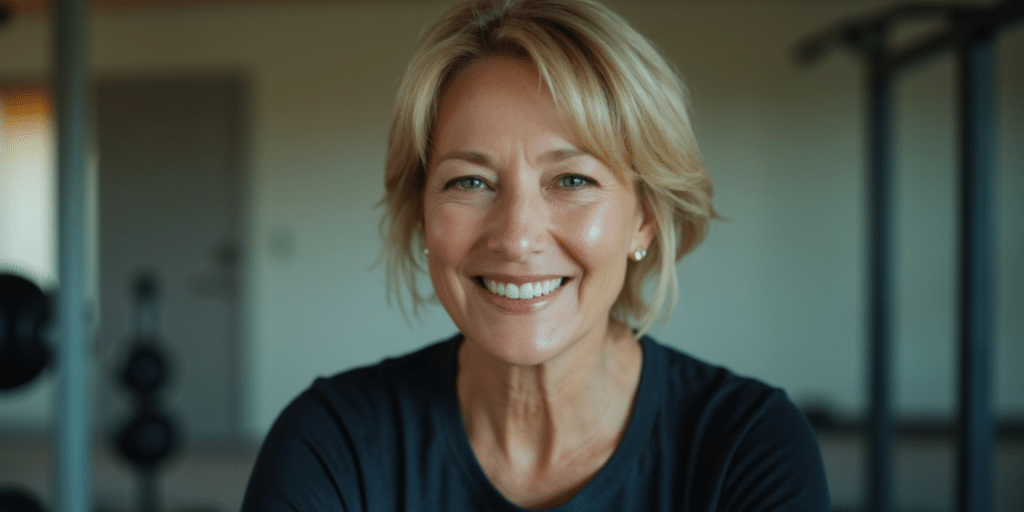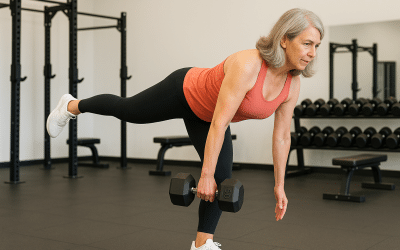Strength Training for Women Over 50
by Stephen Holt, CSCS – ACE Personal Trainer of the Year
I’ve specialized in training women over 50 for the majority of my 35+ years in the fitness industry, and one of the biggest myths I hear is, “Losing muscle and getting weaker is just part of aging.”
I can’t tell you how many times I’ve worked with women who thought they had to accept feeling slower, stiffer, and less capable—until they started strength training.
Within weeks, they felt stronger, moved better, and realized they didn’t have to settle for decline.
Strength training for women over 50 isn’t just only about exercise—it’s about staying independent, mobile, and confident.
Muscle naturally declines with age, but that doesn’t mean you’re powerless. With the right approach, you can build strength, improve bone density, boost metabolism, and enhance overall physical fitness—at any age.
Many women start training with me because they’re frustrated. They’ve tried walking, yoga, or light workouts, but still struggle with daily activities like carrying groceries, getting up from the floor, or feeling steady on their feet.
That’s because strength training is the missing piece. Training smart matters more than lifting the heaviest weights. You want to build strength that makes your daily life easier.
If you want to feel strong on your next vacation, keep up with your grandkids, or just move without stiffness, strength training is non-negotiable. Let’s break down what works and how you can start safely—no matter your current fitness level.
Why Strength Training is Essential After 50
One of the biggest shifts I see in women over 50 who start strength training isn’t just physical—it’s mental. They go from thinking they’re “too old” or “too weak” to realizing how strong and capable they actually are. I’ve had clients who couldn’t lift their own luggage or felt unsteady on stairs, only to find themselves confidently carrying grocery bags, lifting grandkids, and moving through life with ease after just a few months of consistent training.
Muscle loss isn’t inevitable. Weakness isn’t a given. Strength training for women over 50 is the key to staying independent, improving bone health, and feeling good in your body as you age. Studies show that resistance training can increase muscle mass, strengthen bones, improve balance, and even boost metabolism—things that become even more important after 50.
If you’ve noticed yourself losing strength, struggling with mobility, or feeling stiffer than you used to, the solution isn’t to do less—it’s to train smarter. Strength training doesn’t just add years to your life; it adds quality to those years. Whether it’s keeping up with an active lifestyle, preventing falls, or just feeling more confident in daily movements, lifting weights is one of the best things you can do for your body after 50—and it’s never too late to start.
Table of Contents
Strength Training Builds Stronger Bones
As women enter their 40s, bone density naturally begins to decline, increasing the risk of osteoporosis and fractures. However, engaging in regular strength training can significantly counteract this process. Research indicates that consistent resistance exercise can lead to notable improvements in bone mineral density (BMD) among postmenopausal women. A comprehensive meta-analysis highlighted that exercise positively affects BMD at critical sites such as the lumbar spine and femoral neck, which are common areas susceptible to osteoporotic fractures.
In my years of coaching, I’ve witnessed firsthand the transformative impact of strength training on bone health. One client, Jane, a 55-year-old woman who had been diagnosed with osteopenia, approached me with concerns about her bone health. She was apprehensive about lifting weights, fearing it might lead to injury. Together, we developed a tailored resistance training program focusing on weight-bearing exercises like squats, lunges, and deadlifts, all adjusted to her fitness level.
After six months of consistent training, Jane’s follow-up DEXA scan revealed a 4% increase in her lumbar spine BMD. Not only did her bone density improve, but she also reported feeling stronger and more confident in her daily activities. Jane’s experience mirrors findings from studies that emphasize the importance of exercise in enhancing bone health among postmenopausal women.
Incorporating strength training into your routine sends signals to your body to fortify your bones, thereby reducing the risk of osteoporosis. It’s essential to approach this with a well-structured plan, gradually increasing intensity under proper guidance to ensure safety and effectiveness.
Again, science has proven it’s never too late to start.

It Helps Maintain and Build Muscle
Many women experience weight gain and decreased energy levels after menopause, even with a balanced diet. A significant factor contributing to this is the natural loss of muscle mass, known as sarcopenia, which leads to a slower metabolism.
Engaging in regular strength training can counteract these effects by increasing lean muscle mass, thereby boosting metabolism and enhancing energy levels.
The Science Behind Metabolism and Muscle Mass
As we age, muscle mass diminishes, leading to a decrease in basal metabolic rate (BMR)—the number of calories our bodies need at rest. Studies have shown that muscle mass decreases by approximately 3-8% per decade after the age of 30, accelerating after 50.
This reduction in muscle mass contributes to a slower metabolism and increased fat accumulation. Resistance training has been demonstrated to counteract this decline by increasing muscle mass and strength, which in turn elevates BMR and promotes fat loss. citeturn0search1
Personal Experience: Jane’s Transformation
Consider my client, Jane, a 58-year-old woman who was frustrated with gradual weight gain and fatigue despite maintaining a healthy diet. Understanding the role of muscle loss in her situation, we incorporated a structured strength training regimen into her routine.
Over the course of several months, Jane not only shed the extra pounds but also reported increased energy levels and a renewed zest for life. Her experience aligns with research indicating that resistance training improves body composition and metabolic health in postmenopausal women.
Enhanced Energy Through Strength Training
Beyond weight management, strength training plays a crucial role in enhancing overall energy levels. Regular resistance exercise has been associated with improved functional capacity and reduced menopausal symptoms, contributing to a better quality of life.
Incorporating strength training into your routine is a powerful strategy to combat the metabolic slowdown associated with aging. By building and maintaining muscle mass, you can boost your metabolism, manage your weight more effectively, and experience increased energy levels, leading to a more vibrant and active life after 50.
How to Start Strength Training Safely
Many women over 50 give up on strength training because they try programs that are either too intense or too generic. The key is progressive strength training—starting with exercises that feel challenging but manageable and gradually increasing difficulty over time.
Master the Basics
Before worrying about how much weight to lift, focus on proper movement patterns. The best exercises for strength and mobility include:
- Squats – Strengthen legs and improve balance
- Rows – Support posture and prevent back pain
- Chest Press – Build upper body strength
- Hip Hinges (like deadlifts) – Strengthen the lower back and glutes
- Farmer’s Walks – Improve grip and core stability
Start with Moderate Resistance and Progress Gradually
Embarking on a strength training journey after 50 is both empowering and essential for maintaining health and independence. However, it’s crucial to approach this journey with a focus on moderate resistance and gradual progression to ensure safety and effectiveness.
Understanding Progressive Overload
The principle of progressive overload involves systematically increasing the stress placed on your muscles to stimulate growth and strength gains. This can be achieved by gradually enhancing the weight, repetitions, or intensity of exercises. For women over 50, this approach is particularly beneficial, as it allows the body to adapt without undue strain, reducing the risk of injury.
Prioritizing Proper Form
Before increasing weights or intensity, mastering the correct form for each exercise is paramount. Proper technique ensures that the targeted muscles are effectively engaged and minimizes the risk of injury. Starting with lighter weights allows you to focus on movement patterns, building a solid foundation before progressing.
Personal Experience: Jane’s Journey
Janet was 55-years-old and new to strength training. Because she was eager to see quick results (aren’t we all?), she initially pushed herself with heavy weights which lead to discomfort and fatigue. Eventually, she realized she needed a safer approach, and we focused on mastering proper form first. Over time, by gradually increasing the challenge, Janet not only gained strength but also confidence—all while remaining injury-free.
Implementing Gradual Progression
To effectively incorporate progressive overload:
- Start with Manageable Resistance: Choose weights that challenge you without compromising form.
- Monitor Your Body’s Response: Pay attention to how your body feels during and after workouts, adjusting intensity as needed.
- Adjust One Variable at a Time: Whether it’s increasing weight, adding repetitions, or reducing rest periods, modify only one aspect to prevent overexertion.
- Celebrate Small Milestones: Acknowledge and take pride in your progress, no matter how incremental.
The Role of Supervision and Support
Engaging with a knowledgeable fitness professional can provide personalized guidance, ensuring exercises are performed correctly and progression is tailored to your individual needs. This support is invaluable in building a sustainable and effective strength training routine.
Common Strength Training Myths
Strength training for women over 50 should be approached with an understanding of your body’s needs and limitations.
A lot of misinformation surrounds strength training for women over 50. Here are some of the biggest myths—debunked.
“Lifting weights will make me bulky.”
Women don’t have the testosterone levels to bulk up like men. Strength training will make you leaner and more defined.
“Strength training is bad for my joints.”
When done correctly, resistance training protects joints by strengthening the muscles around them.
“I need to work out every day for results.”
Training three to four days per week is enough to build strength and see progress.
“I should only do low-impact exercises.”
While some low-impact exercises can be beneficial, avoiding strength training altogether accelerates muscle loss and weakens bones.
How to Stay Consistent
Even with the best plan, motivation can be a challenge. The key is to make strength training part of your routine in a way that feels manageable and enjoyable.
Set Performance Goals Instead of Just Focusing on Weight Loss
Shifting your mindset from “I need to lose weight” to “I want to get stronger” makes training more rewarding. Instead of obsessing over the scale, track your progress by setting strength goals.
Remember, strength training for women over 50 is essential for maintaining your health and vitality.
Track Your Progress
Keeping a workout log helps you see how far you’ve come. Tracking your reps, sets, and weights allows you to stay motivated and notice small improvements.
Find a Support System
Strength training is easier when you have accountability. Whether it’s a coach, workout partner, or online community, surrounding yourself with people who encourage you makes all the difference.
Frequently Asked Questions about Strength Training for Women Over 50
How often should a 50-year-old woman lift weights?
For the best results, aim for 3-4 strength training sessions per week. This allows enough recovery while maintaining progress. With proper guidance, strength training for women over 50 can lead to impressive results in strength and fitness.
Should women over 50 lift heavy weights?
Yes! Lifting heavier (within your ability) is essential for maintaining strength, bone density, and overall function. Avoiding resistance training leads to faster muscle loss.
How long does it take to build muscle for a woman over 50?
Most women notice strength gains in 3-4 weeks and visible muscle definition within 8-12 weeks, as long as they train consistently and eat enough protein.
What’s the best type of strength training for women over 50?
A balanced program might include:
– Squats (leg and core strength)
– Rows (posture and back health)
– Chest presses (upper-body strength)
– Hip hinges like deadlifts (glute and back strength)
– Carries (farmer’s walks) (grip and core stability)
Is strength training better than cardio for women over 50?
Both have benefits, but strength training is essential for maintaining muscle, bone density, and mobility. Cardio is great for heart health, but without strength training, you risk losing muscle and slowing your metabolism.
What’s the difference between strength training and weightlifting?
Strength training includes dumbbells, bodyweight exercises, kettlebells, and machines to build overall strength. For women over 50, strength training—not competitive weightlifting—is the priority.
Can I build muscle if I’m over 50?
Yes! Women over 50 can build muscle effectively with progressive resistance training and adequate protein intake.
How do I know if I’m lifting enough weight?
You should struggle on the last few reps of each set while maintaining good form. If the weight feels too easy, it’s time to increase the challenge.
What’s the best way to stay motivated?
Set performance-based goals (e.g., lifting a certain weight, improving balance)
Track your progress in a workout log
Find a community for support and accountability
Final Thoughts
Strength training is a powerful tool for women over 50 to enhance health, vitality, and independence. By incorporating regular resistance exercises into your routine, you can improve muscle strength, bone density, metabolism, and overall quality of life.
If you’ve been told that strength training isn’t for women over 50, it’s time to challenge that mindset. Strength training isn’t about lifting the heaviest weights—it’s about building strength, maintaining independence, and feeling your best at any age.
Start small, stay consistent, and celebrate progress. Your future self will thank you.





